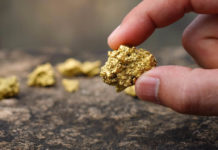
[miningmx.com] – SIBANYE Gold CEO, Neal Froneman, declared his company no longer had an interest in buying gold assets, and said the days of seeking cross-boundary synergies between neighbouring gold mines were over.
“We are not buying assets anymore in the gold sector. We have bought the assets we need,” said Froneman in an interview. “Our focus is about doing material transactions to make a meaningful difference,” he said.
According to Froneman ‘material transactions’ is defined as merger and acquisitions between gold industry compatriots such as AngloGold Ashanti and Harmony Gold; a type of deal-making on a scale that would involve stakeholders as well as shareholders.
“Asset swaps are a temporary measure of improving things. The area where industry can make a meaningful difference is in its overhead structures. This is not just about shareholders, but stakeholders.”
Asked at the firm’s interim results presentation why then there had been no demonstrable activity with the likes of Harmony Gold, far and away the most distressed of the meaningfully sized gold mining companies in South Africa, Froneman equivocated.
Harmony Gold wasn’t the slam dunk target of any consolidation, he said.
“We are not competing with Harmony or AngloGold,” he said in the interview with Miningmx. “We are competing with the Newmonts [Mining] and the Barricks [Gold] of this world and we should step-up to the plate.
“We have to build an South African gold company that can compete on a premium basis in terms of rating, with a good quality resource and in a labour intensive environment where we can be one of the lowest all in cost producers in the world,” he said.
Sibanye Gold increased production 13% year-on-year but its operating profit was flat. It lifted the dividend, but the issue is whether it had wrung most of the benefits from its initial debut in 2012.
Froneman acknowledged that a lot of the “low hanging fruit” in terms of cost-cutting had been “taken out of the business”, but there were still operational improvements that would feed to the bottom line eventually, he said.
Apart from the ramp-up for the Cooke shafts, Sibanye Gold was sitting on an inventory of some 180,000 pounds of uranium oxide which would be delivered into the market once it had found a long-term customers, most likely a utility interested in consistent supply, the company said.
Froneman said the uranium was probably worth about R100m “in round numbers” and would be accounted for as a co-product of gold; that is, not as a revenue line entry.
“The benefit of a co-product is $100 to $200/oz off your cost line. If all-in costs are $1,200 per ounce, then you can bring them down to $1,050 to $1,000/oz,” he said.
Sibanye Gold said it had increased gold reserves to 28.43 million ounces in 2014, a 44% increase after depletion. Uranium mineral reserves increased to 102 million pounds (mlbs) from 43.2 mlbs. Organic growth would further leverage the company’s existing infrastructure, he said.
It also narrowed its project pipeline. The Kloof 4 and Driefontein 5 shaft infrastructure project which would access 1.7 million oz of gold topped the list along with the West Rand Tailing Retreatment Project, Burnstone and the Beatrix West Section (Beisa) project which was under pre-feasibility tests.
Some R286m had been approved in capital expenditure for Burnstone, a mothballed gold mine in Mpumalanga province once owned by Wits Gold and developed by the now defunct Great Basin Gold before it.









